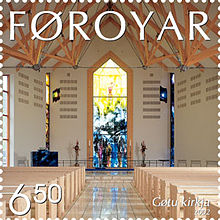Gøtu Kirkja
Gøtu Kirkja is the modern church building in the municipality of Gøta / Faroe Islands . It stands in Gøtugjógv and was consecrated in 1995.
The new church in Gøta was consecrated on June 25, 1995 by Bishop Hans Jacob Joensen in the presence of Queen Margrethe II and the Nordic bishops. It belongs to the parish of the - also ultra-modern - Fríðrikskirkjan in the parish of Nes (Eysturoy) . As there, it replaces an old wooden church that had become too small to meet the requirements of today's community.
The church with its 270 seats was designed and projected by the company Landsbyggifelagið , while the artist Tróndur Patursson was responsible for the artistic design.
The construction of the bell tower is based on three crosses, which symbolize the crosses on Golgotha . The two bells of the church bear the following inscription: Eg ringdi yvir bygdir hvøll, eg kalli fólkið: komið øll (I ring over the villages, I call the people: everyone comes over). As with Christianskirkjan in Klaksvík, the tower is isolated from the main building.
Verland Johannesen's organ dates from 1973. It was originally built for Tórshavn Cathedral , but was later given as a gift to Gøta Church. It was officially put into use on October 12, 1997.
Tróndur Paturssons total work of art

Six lamps hang from the ceiling, and there were originally twelve small and twelve large glass wall lights on the walls. The large wall lights are each decorated with a cross. The number twelve is related to the twelve apostles , the ancestors of the Christian church, who in turn refer to the twelve tribes of Israel and their ancestors, the twelve sons of Jacob.
The artist Tróndur Patursson is based in Kirkjubøur , where you can see twelve consecration crosses in the wall of the cathedral ruins ( Kirkjubømúrurin ). In pre-Reformation times, part of the Roman Catholic liturgy for church dedication consisted of the bishop drawing and anointing twelve consecration crosses . Mostly the consecration crosses were painted on the church walls with lime paint, but they could also have been attached to the wall beforehand, as in the cathedral ruins of Kirkjubøur. This liturgical tradition was abolished after the Reformation, but today we can find the twelve crosses on the twelve large wall lights. However, these played no role in the dedication of the church.
The baptismal bowl is blue like the sea. The stand of the baptismal bowl is flame-shaped, and the seven candles under the baptismal bowl are lit during the christening act. Fire is a symbol of the Holy Spirit. John the Baptist says in Matt. 3,11: I baptize you with water for repentance; but he who comes after me is stronger than me, and I am not worth wearing his shoes; he will baptize you with the Holy Spirit and with fire.
The glass mosaic in the choir is divided into three parts. On the left, the bright colors in the two upper fields symbolize the heavenly glory before creation. In the third field you can see creation: Adam and Eve . In the fourth field the fall into sin can be seen: Eve and the serpent. The fifth field shows chaos - disorder, destruction and downfall.
The middle section behind the altar table shows the world in which we live. The colors of the window are initially the same as in the chaos field on the left. You can see a rock cut through by a ravine. On the left, people can be seen looking over the sea and looking for a boat. They hope it makes it safely to port. There is a double meaning in their lookout: they not only see the boat, but also Jesus - hope and salvation.
On the right-hand side you can also see a boat heading for a rock with a light shining over it. In addition to the naturalistic interpretation of the picture, this can also be seen in connection with the middle window, namely as the light sent by God into the world.
The image of Jesus can be interpreted in two ways. Immediately one can see it as crucified, but one does not see the cross. At second glance, you no longer see the darkness of Good Friday , but the Easter light streaming towards us.
Web links
- Stamps.fo - Church in Gøta (public domain and basis of this article)
Coordinates: 62 ° 11 ′ 37 " N , 6 ° 44 ′ 46.5" W.
